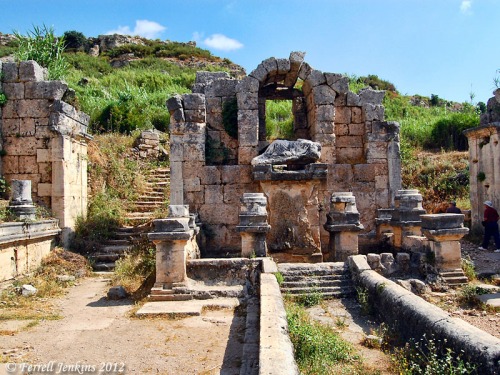'via Blog this'
Docking again at Perga
A few days ago we had some discussion here about whether Paul and his companions docked at Atttalia or Perga after sailing from Paphos, Cyprus.
Now Paul and his companions set sail from Paphos and came to Perga in Pamphylia. And John left them and returned to Jerusalem, but they went on from Perga and came to Antioch in Pisidia. (Act 13:13-14a ESV)
Darryl said that he had been unable to track down the oft-cited reference in Strabo Geography. I located the quotation using Logos 4. The modern names are included in brackets.
[2] Next is the river Cestrus [Ak-su]; on sailing up its stream 60 stadia we find the city Perge, [Murtana] and near it upon an elevated place, the temple of the Pergæan Artemis, where a general festival is celebrated every year.
Nymphaeums (fountains) were important in Roman cities. The fountain at Perga flowed into a channel running the length of the main street.

The Nymphaeum (Fountain) at Perga. Water flowed from the fountain into a channel in the middle of the main street. Photo by Ferrell Jenkins.
This close-up view shows the river god Cestrus. Water flowed under the image into the channel. Other cities had a similar image with the water flowing from a cornucopia held by the river god. At Ephesus it was the god Cayster.
Dr. Combs recommended the article by Douglas A. Campbell (“Paul in Pamphylia (Acts 13.13-14a; 14.24b-26): A Critical Note”) in New Testament Studies (2000): 595-602. This afternoon I was able to get access to the article. The map is especially helpful.
Campbell says the 175 mile trip from Paphos to Perga, with favorable winds, would have taken between 25 and 50 hours, but with difficult winds it could have taken longer. It would be more common for ships transporting goods from Cyprus to Perga and other cities in the region to have used the River Cestrus. On the return from the first journey, when Paul was headed east back to (Seleucia, then) Antioch (Acts 14:25-26), it would have been best to use Attalia as the port (as Tim Brinley also pointed out in his comment).
Some other sources explaining that Perga used the river Cestrus as a port include the following:
- E. A. Judge. Perga. The International Standard Bible Encyclopedia, Revised (3:767-768).
- E. M. Blaiklock. Perga. New Bible Dictionary (3rd ed.): 901.
- A. E. Hillard. Perga. (Hastings) Dictionary of the Bible: 700.
An inland city of Pamphylia about 12 miles from Attalia on the coast, but possessing a river harbour of its own on the Cestrus 5 miles away. Its walls date from the 3rd century B.C.
From Perga Paul would have taken the Via Sebaste to Pisidian Antioch. When he returned to Perga, using the same Roman road, he would have taken the Claudian extension of the Via Sebaste which ran southwest for 12 miles to Attalia.
Campbell, a British scholar, says,
In my judgement the author of Acts at these two junctures is, quite simply, spot on.


No comments:
Post a Comment